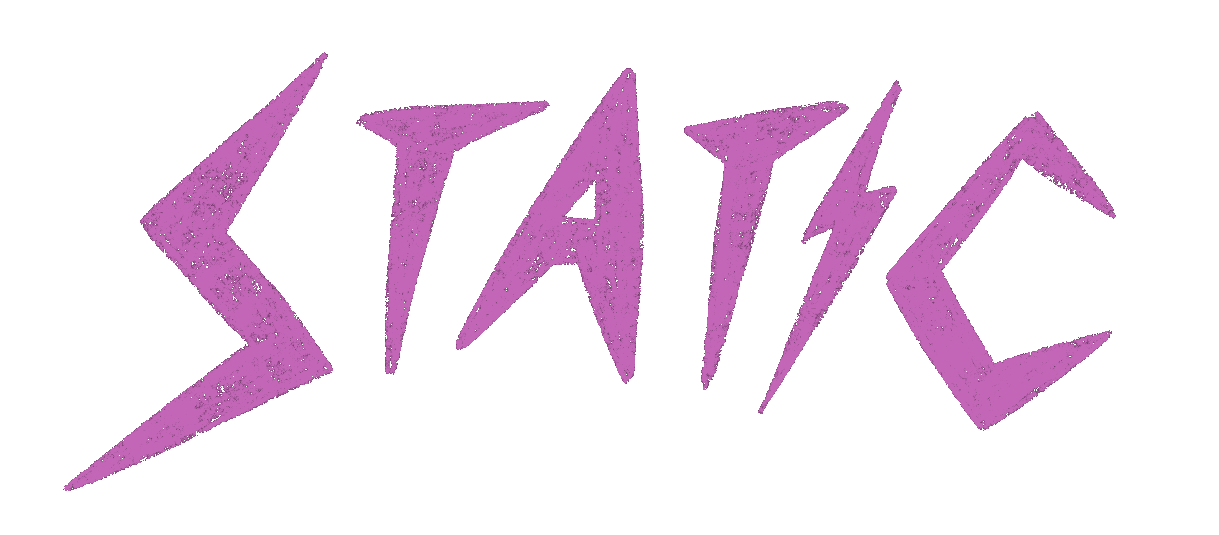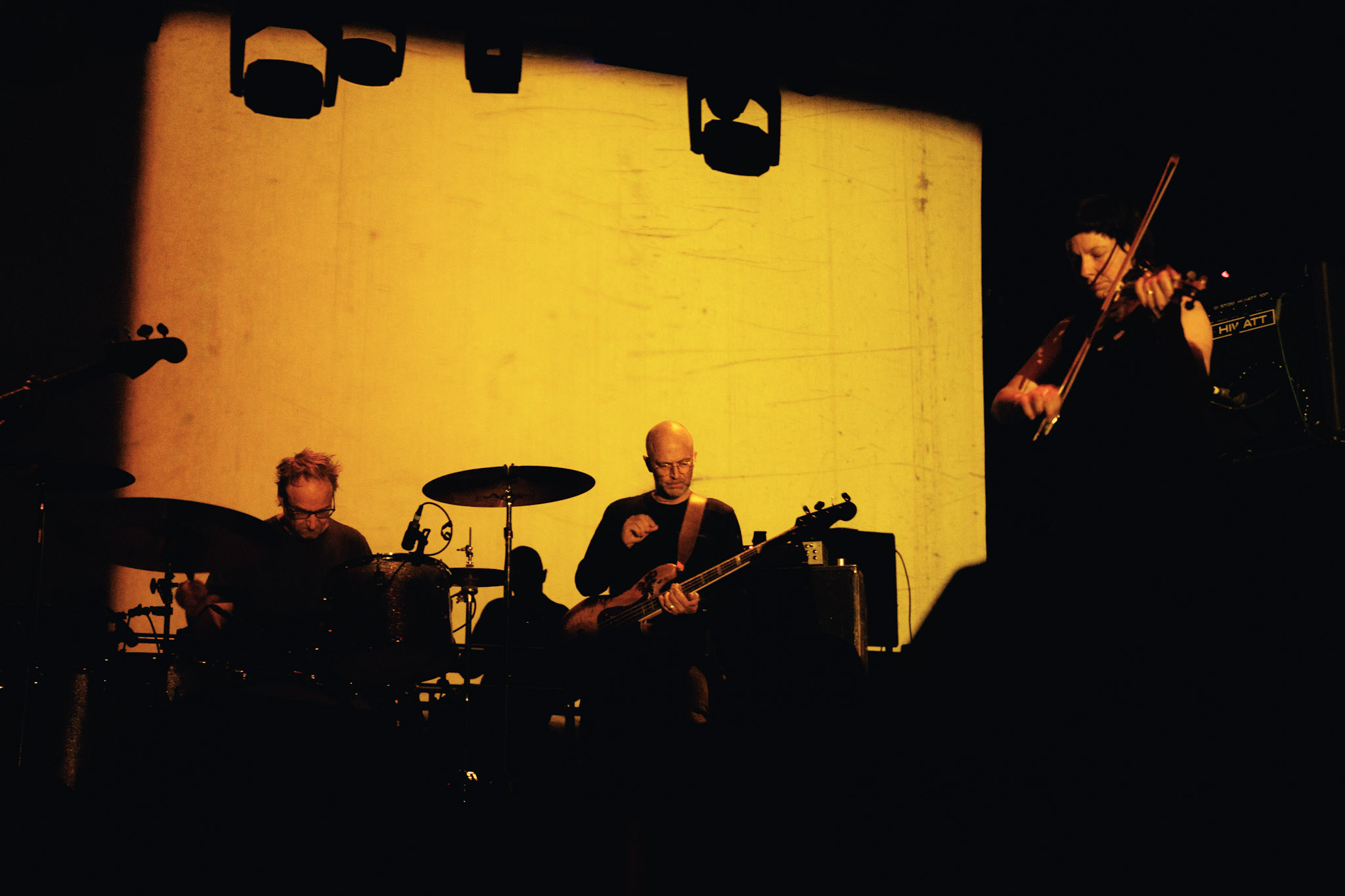Never had I seen so many pedal boards. They littered the stage, some of them so comically expansive that it felt cheap to poke fun. Details like this would only be clear for a few more minutes before Godspeed You! Black Emperor hit the stage.
Of the three potent opening acts preceding Godspeed, Maria BC’s haunting performance shone brightest in their subdued vocals. Gently entrancing, they were more notable than Alan Sparhawk’s raw expression in his first American tour of solo works outside of Low. Following Mimi Parker’s death and the subsequent disbanding of Low, Sparhawk has been doing more rounds of solo performance. Though his brazen energy was certainly captivating, the set was largely forgettable.

In the interim, the stage of Knockdown Center was completely cluttered by instruments, monitors, and two drum sets. Efrim Menuck, the legendary founder of Godspeed donned an impressive winter coat as he entered and exited the stage while the crew set up the stage. To get all of the pieces of technology needed for a Godspeed show was a performance in and of itself; 3 guitarists, 2 electric bassists, 2 drummers with full drum sets each, one violinist, and one upright bassist could be somewhat seen in the dim light. There is a very real chance one of the bassists was actually a guitarist – it was too dark to tell.
“Hope Drone” opened their 5 song (but by no means short) set. Some post-rock bands, or really any genre with the prefix “post”, seem to have far too many instruments for their own good. The intent, the potential of a single instrument can be lost. What Godspeed proves time and again, most evidently in live performance, is their unique ability to take a crowd of musicians, and make the most beautifully complex noises without wasting a drop of instrumental power. Each instrument, its individual timbre muddled in the haze of pedals, was a limb of a new body, lending purpose to a greater being.

If the deafening intricacy of this show can be somewhat attributed to the sheer number of instruments and speakers, Godspeed would have been lost in the sea of hundreds of other bands whose only real claim to fame is the number of people on stage. The longevity of the band says otherwise. Since its conception in 1997, initially a trio performing genre-pushing post-rock around Montreal, Godspeed’s steady release of music has established themselves as a prominent voice in protest music and uniquely defiant noise. Their audience, ranging from staunchly pretentious /mu users to a charming father and son duo behind me, has only grown throughout their career. Standing in the audience, it seemed to me that the secret to their success was in what can only be experienced live. For many, the appeal of Godspeed is that they have mastered the wall of sound. Each song is a complex composition where one could find bagpipes or just pure noise, but in person, the little lives of each person on stage click together ever so clearly.
It became hypnotic, partly due to the epic lengths of each song, but mostly thanks to the eerie immersion from the almost unsettlingly human sounds emanating from the stage. Obviously humans were the ones playing a guitar with what looked like a conductor’s baton but it was something else, a sort of unnerving refraction of humanity in the moans of the 15 minute songs. It was overwhelmingly fallible; the volume of single notes would have exposed any hesitation, any wavering intonation, but the collective held it to the greater body. It was strange, seeing a mirrored image of yourself: recognizably you but almost too real.


In one song, after a trance of one single chord expanding into itself for what seemed like a last time, the notes finally changed. What would be a part of the first 10 seconds of most songs was a life unto itself, and the people performing seemed to be doing it so naturally, so instinctively.
Their heads bowed over their instruments, looking at each other at particularly gripping moments of musical exchange but mostly keeping to their own corner of the stage. In a way, the moment reminded me distinctly of John Cage’s “As Slow as Possible”. The piece was written for organ and is currently being performed; a German church started a performance of the piece in 2001 and it will end in 2640. In February, for the first time in two years, the piece changed chords. It will not change chords again for another two years. This sense of eternity, of a greater vision beyond whatever you hear in that moment, is precisely what Godspeed captures. In some odd sort of way that may directly oppose the band’s politics, much of the performance felt more similar to a classical concert, of being still and witnessing a living organ (no pun intended) of music be born and die.
Though the audience experience was akin to what my friend from high school describes his DMT cart experience as, reducing this show to its sound would be obscenely reductive, particularly when the band clearly has intentions behind the amp. The film loop projections of Godspeed shows are a longstanding and central part to their live experience, and this show’s felt vividly prescient. There was little to no real lighting on stage and most of the light came from the images flashing from the projector. From the very start of the show, images of buildings and sunsets, footage of protests, and photographs of apparent revolutionaries amongst other snippets of life, were interspersed between flashes of disorienting black and white viscerally moving figures. If the message couldn’t get clearer, the word “Hope” lingered longer than any other image.
Hapless inferral of a band’s political intention and the success of that aim is a pitfall of music journalism. Artists in the modern era tend to let audiences guess at political alignments, revealing bits and pieces through vague Instagram reposts and open letter signings in an attempt to keep a shred of moral dignity without losing any audience. Evading any guessing game, Godspeed hands their thoughts on a bright, silver reel. The band has always been very vocal about their political views; frontsman Manuck is a self-described anarchist and in a 2014 interview said he believes all music is political. Godspeed’s radio silence in most interviews and internet presence is opposed just as much in these concert visuals as the sound on stage. At times jarring, the visions of burning buildings are a reminder that despite being almost three decades in the game, they are decrying the powers that be as loudly as always.

For a moment, when I saw the handwritten font spelling out “Hope,” I broke out of the spell and felt annoyed. It seemed briefly too millennial, too performative to slap on a little bon mot and call it activism. Half a second later, the chord changed again and I was once again enraptured, but my short-lived disdain, dear reader, is precisely what Godspeed seems to be trying to combat. In a world where most musicians remain completely silent in the face of constant tragedy, there is nothing more useless than to scoff in the face of music that fights against something, that stands for something. Pure artistic earnestness, devoid of self-deflecting satire, is so painfully hard to get these days, and is exactly what the hours standing in front of this band offers.
For the next hour and lifetime, after five songs (3 of which were debuts!), it ended. Their owners left the stage, but the instruments’ thrums of the last chord stayed behind. Manuck threw up his hand as he walked off, something in between a peace sign (for the hopeful) and just some sort of acknowledgement of the crowd. After raucous applause, a man returned, slowly going around the stage. Little by little, the last pedal was stepped on, the last monitor turned off, and the final note decayed. But it would be silly, really, to think something didn’t linger still.

